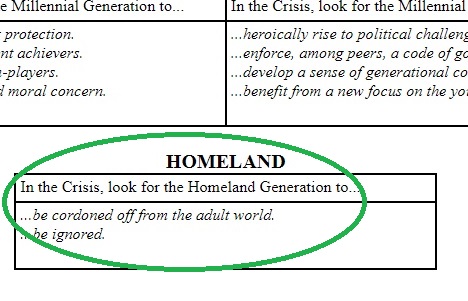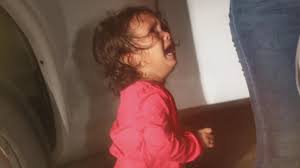Growing Up in Crisis America
When one reads in online media about the generations that are alive today, it is most typically a story contrasting the Baby Boomers with the up and coming Millennials. Sometimes my generation, Generation X, gets a mention. In other blog posts, I have referred to the Silent Generation. You may even have read about the post-Millennial Generation Z, usually said to have been born starting some time in the late 1990s.
Clearly some generation must follow the Millennials, but I have my doubts about the Gen-Z concept. In the generational theory which I study, the next generation, still in childhood, is called the Homeland generation. This name was coined early in the century, around the time that the Department of Homeland Security was instituted in response to 9/11. The name evokes the idea of a country entering protective mode, and of a generation that is sequestered within it.

With the first birth year of the Homeland generation being 2005, the oldest of their members are just turning 14. What can we say about this child generation and their experience growing up in an America in crisis?
The Homeland generation has clearly been the beneficiary of the restoration of the American family that began when Millennials started being born in the 1980s. The era of rising protection of children has reached its apex; children are now completely ensconced within the family unit. You can see it online in social media with the endless stream of posts of happy families headed by Gen-X parents – and, increasingly, by Millennial parents.
Protective child nurturing has reached the point that there is are hints of concern that overprotection has gone too far. But despite memes extolling the free-wheeling child rearing of days past, there is little sign of the protection relenting. Instead, in a shift away from the way that Millennials were raised, Homelanders are being taught not so much that they are special and unique, as that they must learn to fit in and to get along with others. It’s a trend propelled by concern for the perceived negative consequences of being a social misfit in a time of rising suicide rates and mass shootings, or of standing out in an era of social media scrutiny.
Homelanders, in fact, are the first generation to have their entire lives documented on social media. It starts when they are still in the womb, with sonograms posted by excited expecting couples. Then comes a flurry of adorable toddler posts, capturing every precious moment. Once they hit school age, there is a mandatory start of the school year portrait for every grade from kindergarten on. My favorite indicator on social media of the centrality of family in American life, and the Homelander generation’s comfortable place within it, is the themed costume group photos that come out every Halloween.
It seems to me like Homelanders are always on exhibit. If not as the trophies of proud parents and grandparents, there are two prevalent ways in which Homelanders are put on display. One is the viral video featuring a toddler in some moment of discovery or precious and adorable behavior. Follow this link for a great example.
The other prevalent way that Homelanders are put on display is in the role of victims, as object lessons about the failures of our society. Movies like The Florida Project and Beasts of the Southern Wild portray young children in trying circumstances, on the economic fringes American life. Another example, What Maisie Knew, warns of the follies of the affluent and the damage that divorce and neglect do to a child.

The Homelanders who are truly on the fringes of American life are the undocumented migrants – their status raises doubts that they even belong to the homeland at all. The political left has made ample use of images of their tribulations to protest immigration policy. One photo of a crying toddler being processed by immigration authorities has become an iconic representation of these suffering innocents, caught on the edges of a fragmented society that is, with difficulty, trying to group itself back together.
In conclusion, the Homelander experience is reflective of the needs and priorities of their Gen-X and Millennial parents – to restore family stability, and to provide a controlled and safe environment for child nurture within a society that feels out of control and unsafe. With these goals in mind, children are being taught that rather than stand out, they should fit in. Rather than express emotions, they should manage emotions.
This is the opposite of how Generation X was raised half a century ago, at a time when family stability was not a priority, and parents sought to provide a free environment within a society that felt overly controlled and limiting. The reversal is a response by Gen-X, conscious of the failings their generation has faced as a consequence of lax parenting. Today’s parents will surely make there own mistakes, as all parents do, taking on what is the most difficult of all human endeavors. They will take things too far, and so set up the course corrections that will lead to another shift in how children are raised, for a new generation yet to be born.
To end this post on a positive note, here is a wonderful example of an adorable young Homelander viral video. These kids are our future.
7 thoughts on “Growing Up in Crisis America”
Hey, this is Chas, I have to caution against including What Maisie Knew. The original book was about a British Contemptible (i.e. Lost), and with the exception of the ending, the film simply modernized the plot. So, it’s not really about a Homelander experience IMO.
That’s a great point, Chas. The one aspect of the movie where it feels like Maisie is a Homelander is how she is so sweet and sensitive to the needs of her guardians (who eventually become her parents). I wonder what a modern story about Homelanders with affluenza would be like.
Why make boxes for us? Why make it so complicated? Can’t we just fit together as 1 unit…. a family? Age categories and differences blending instead of separating And everyone respecting and loving each other wherever they are. I just feel I don’t fit in a box.
As soon as Adidas asks the question of my age, I know they will throw me into an old lady box. As soon as I place that 75 in the answer section, I know they are going to blow me out of the water. What do I know of style, comfort and color, texture and quality?
Or… do I sound old fashioned because I would rather one see the heart and the eyes instead of the make up? Or the face instead of showing the low cut style of clothing that reveals a bit too much for comfort? You can read a person much better with eye contact.
I prefer Jesus’s idea of loving everyone, whether differences , even sins , or past hurts or deliberate unkindness. I always have hope it can be mended by love.
Ok Steve. Enough for the day. I guess I have too much time to sit and think. You’re helping my brain trying to process this trend. Thank you for sharing. I miss you in person.
Mama Lu
Lucy, that is a fair judgement of looking at people in terms of generations. Amateur sociologists like me put people in boxes because grouping and categorizing helps us understand patterns and make sense of the world. But something is always lost by labeling people instead of confronting them for who they are as individuals. No one is bound to a certain way of being because of their age or generation.
I miss you too, Mama Lu. I hope we get to see you this summer.
In a new post I reviewed the three movies mentioned in this post. Check it out-
https://stevebarrera.com/the-homeland-generation-in-film/